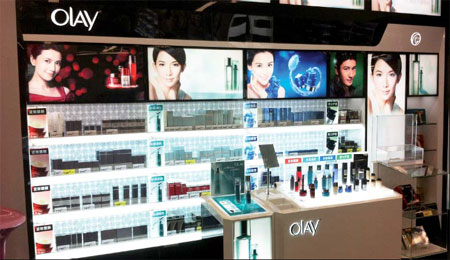Face cream leaves its mark on China and the world
Updated: 2012-11-23 09:08
By Yao Jing (China Daily)
|
|||||||||||
|
Olay, owned by Procter & Gamble, has made big inroads in China as a widely known skin-care product. Provided to China Daily |
Olay has had a few makeovers in its 60-odd years, but the old girl still has a spring in her multibillion-dollar step
A couple of weeks ago Zou Hao, who works at a trading company in Shanghai, splashed out 1,000 yuan ($160; 126 euros) online for skin-care products.
Zou, 28, has been aware of the US brand Olay since his mother used its products when he was a child. Later, when he was at college, he decided that for him skin care was important, and he began using moisturizing products.
"Although I use other high-end brands, I have stuck with Olay's products because I know them well and they are cheaper compared with other big names."
Olay, owned by the retail giant Procter & Gamble, has made big inroads in China as a widely known, affordable range of skin-care products. However, faced with a more segmented cosmetics market, those who sell Olay are trying to broaden the product's appeal.
Zou is an interesting case study because he represents one strand of Olay's strategy of widening its appeal: putting products for men on the market, something it started doing in China in 2010.
The sort of money at stake is apparent when you consider that Procter & Gamble proudly calls Olay and 23 more of its products "billion-dollar brands", and Olay with three other beauty businesses together accounted for almost 24 percent of the company's net revenue of $83.7 billion last year.
In April, London consultancy Brand Finance named Olay as the world's top beauty brand, saying it was worth $11.8 billion.
"We hope to clearly define the image and beauty promise of the brand in each niche market," says Li Jing, director of the brand's communications and PR in China.
Chinese people have become a lot more sophisticated in their skin-care needs, she says. Gone are the days when keeping skin moist was enough. Now there is high demand for anti-aging, whitening, and anti-acne products.
"Consumers are becoming mature and letting us know what they need," Li says.
Responding to the changes in the market, Olay, which has been on the market for 23 years, launched the concept "House of Olay" in China last year, splitting the brand into three sub-brands targeting different types of consumers.
More Chinese consumers are opting for more sophisticated and expensive products, and Olay's Pro-X anti-aging and anti-acne is squarely aimed at them.
"The relatively high-end line is available only in department stores, targeting customers that look for professional beauty solutions which benchmarks prescription and premium merchandise," Li says.
Since the line was launched in 2009, its eye restoration complex, which sells for 360 yuan, has become a best-seller. Cleansers are now also selling well.
"Olay will continue focusing on the masstige market, drawing more deeply on the current sales channel," Li says.
Yu Wei, a principal at Roland Berger Management Consultants (Shanghai) Co Ltd, says the brand, with turnover of more than 3 billion yuan a year, is a great success. That may be so, but it has had better days. Last year it accounted for 9.5 percent of the Chinese cosmetics market, compared with 14.9 five years earlier, Yu says, citing a report by Euromonitor.
Olay, compared with brands developed or managed by cosmetics companies, has an advantage in the mass market in that being owned by Procter & Gamble it gains easy access to hypermarkets and retailer chain stores.
But the increasing competition from domestic brands at the lower end of the market, coupled with many consumers migrating upmarket, means Olay is now fighting a marketing war on two fronts.
"It is a single brand, but products carrying its label range from 20 yuan to hundreds of yuan," Yu says.
"Olay is a rare phenomenon because most of the cosmetics giants target different markets with different brands. Most consumers will not accept high prices for products bought from the shelf. And if it wants to compete with other big names in department stores, it has a long way to go.
"As an early comer to the market we were not just interested in being compared with other brands. Instead, we laid great stress on understanding our consumers."
One area for future growth is products based on natural ingredients, Li says. "We will give consumers whatever they want."
Olay is said to have had its roots in South Africa about 60 years ago, when Graham Wulff, a former Unilever chemist, formulated a pink moisturizing lotion and called it Oil of Olay. It was eventually bought by Procter & Gamble. It has been marketed in different countries under various names, including Oil of Olay, Oil of Ulay and Oil of Ulan. It is now known in most places simply as Olay, but in some European countries, including Germany and Italy, it is marketed as Olaz.
yaojing@chinadaily.com.cn
(China Daily 11/23/2012 page13)
Today's Top News
Rescuers race against time for quake victims
Telecom workers restore links
Coal mine blast kills 18 in Jilin
Intl scholarship puts China on the map
More bird flu patients discharged
Gold loses sheen, but still a safe bet
US 'turns blind eye to human rights'
Telecom workers restore links
Hot Topics
Lunar probe , China growth forecasts, Emission rules get tougher, China seen through 'colored lens', International board,
Editor's Picks

|

|

|

|

|

|






